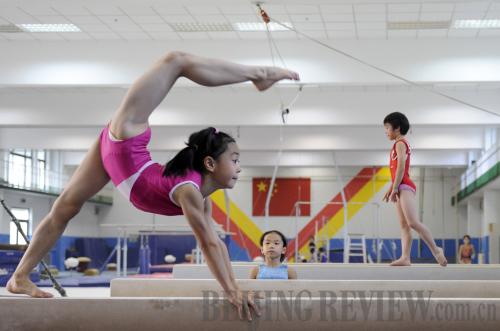|
 |
|
YOUNG ATHLETES: A 9-year-old girl (first left) practices a gymnastics routine on a balance beam at Shichahai Sports School in July 2008 (LIU DAWEI) |
The young athlete had the prototypical build of a gymnast. He was small, with a low-center of gravity, but built entirely out of muscle. Broad shouldered, with a rippling six-pack and a steely look of determination on his face, he knew what he wanted and what he had to do to achieve it. He alternated between a set of pushups and a set of situps, the latter of which was performed a couple of feet above the ground, with his legs wrapped around a horizontal wooden pole. "One more, one more," his coach yelled, as the athlete's legs quivered, threatening to give way at any moment.
This could have been the training routine of any elite athlete. The difference in this case was that this athlete was a 6-year-old boy. His story is but one of hundreds from China's renowned Shichahai Sports School.
Shichahai, China's "cradle of champions," is not simply a stopping-off point for the gifted. It is one of the world's top breeding grounds for Olympic competitors, with an honor role boasting over 200 national champions, seven Olympic gold-medalists, 33 world champions and martial arts film star Jet Li.
From the outside, the school is a fairly unassuming compound. Located near the hive of activity that is Beijing's Qianhai Lake, Shichahai appears rather quaint in comparison. Inside, the school is a well-oiled machine, with rotors churning at full capacity and the athletic production line set to overdrive.
Martial artists, gymnasts, boxers, fencers and volleyball, ping pong and badminton players dart between the 13 training halls that stretch across the 40,000-square-meter complex. These are the halls where Olympic champions like Luo Wei, the 2004 taekwondo gold medalist and Zhang Yining, four-time ping pong gold medalist, honed their craft. Surveying the athletes, people could not help wondering: Were these China's next Olympic superstars?
Chinese dominance
Shichahai is at the forefront of China's sporting ascendancy. In 1986, when Shichahai was transformed from a recreation center to an elite sports school, China had only just entered the ranks of Olympic competitors, with their first appearance at the 1984 Summer Olympics in Los Angeles.
A generation later, China claimed top honors at the 2008 Beijing Olympics, earning 51 gold medals and breaking the United States' record for total gold medals won at a non-boycotted Olympics.
China's success was no mere hometown advantage however. This was the result of a concerted effort from the Chinese Government and schools like Shichahai to stake their claim as the world's premier sporting nation.
The Chinese Government had long realized economic clout alone was insufficient. China's dominance also had to extend to the sporting arena.
"For the government, it was important to validate its strength through sport, and to dispel the image of China as the 'sick man of Asia'," Shi Fenghua, vice principal at Shichahai, told NY Daily News.
Today, no sports fan would refer to China as a "sick man." The country's transformation from sporting also-ran to global heavyweight has been staggering. And it was on the courts and fields of Shichahai, and similar schools, where this athletic revolution was fulfilled.
For many of Shichahai's students, the process began when they were as young as 4 years old. Scouts and coaches combed the countryside, seeking out kids with long arms or double-jointed elbows, and then, with some well-directed scholarship funds, placed them on the Shichahai production line.
Jamie Metzl, an executive vice president of the Asia Society, told the Inquirer that this process is the key difference between American and Chinese training academies.
"Our [American] system is designed for the people with passion and talent," Metzl said. "Theirs is much more centrally organized. China is a country run by engineers."
| 